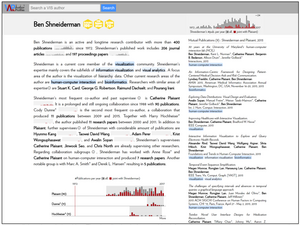The Research Group is Moving!
During winter term 2021/22, we move to University of Bamberg. From Oct. 15, 2021, Fabian Beck holds a full professor position on Information Visualization.
New webpage of the research group: https://www.uni-bamberg.de/vis
Publications
Publications of the research group since 2016. For earlier publications, please visit Fabian Beck's Google Scholar or DBLP profile.

Type of Publication: Article in Journal
VIS Author Profiles: Interactive Descriptions of Publication Records Combining Text and Visualization
- Author(s):
- Latif, Shahid; Beck, Fabian
- Title of Journal:
- IEEE Transactions on Visualization and Computer Graphics
- Volume (Publication Date):
- 25 (2019)
- Number of Issue:
- 1
- pages:
- 152-161
- Digital Object Identifier (DOI):
- doi:10.1109/TVCG.2018.2865022
- Fulltext:
- VIS Author Profiles: Interactive Descriptions of Publication Records Combining Text and Visualization (4.05 MB)
- Talk associated with this publication:
- IEEE VIS 2018
- Recording:
- https://vimeo.com/300470669
- Citation:
- Download BibTeX
Abstract
Publication records and collaboration networks are important for assessing the expertise and experience of researchers. Existing digital libraries show the raw publication lists in author profiles, whereas visualization techniques focus on specific subproblems. Instead, we look at publication records from various perspectives mixing low-level publication data with high-level abstractions and background information. This work presents VIS Author Profiles, a novel approach to generate integrated textual and visual descriptions to highlight patterns in publication records. We leverage template-based natural language generation to summarize notable publication statistics, evolution of research topics, and collaboration relationships. Seamlessly integrated visualizations augment the textual description and are interactively connected with each other and the text. The underlying publication data and detailed explanations of the analysis are available on demand. We compare our approach to existing systems by taking into account information needs of users and demonstrate its usefulness in two realistic application examples.
